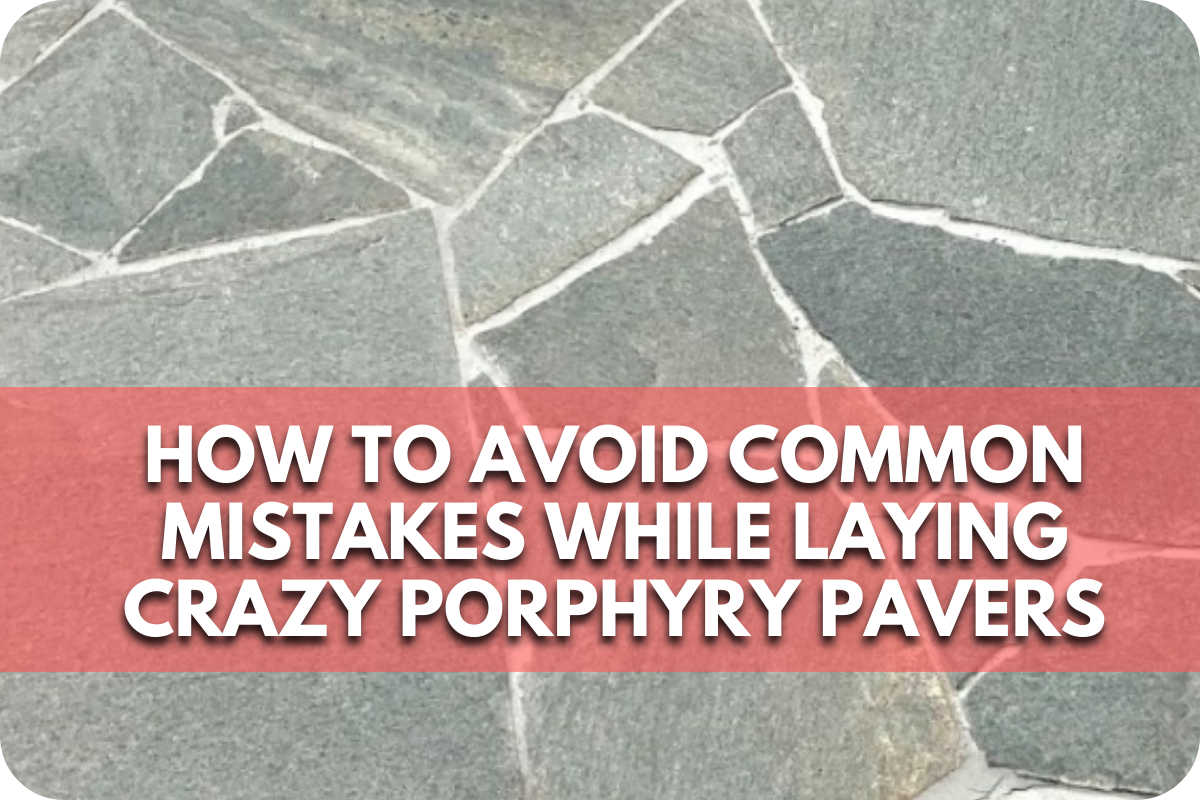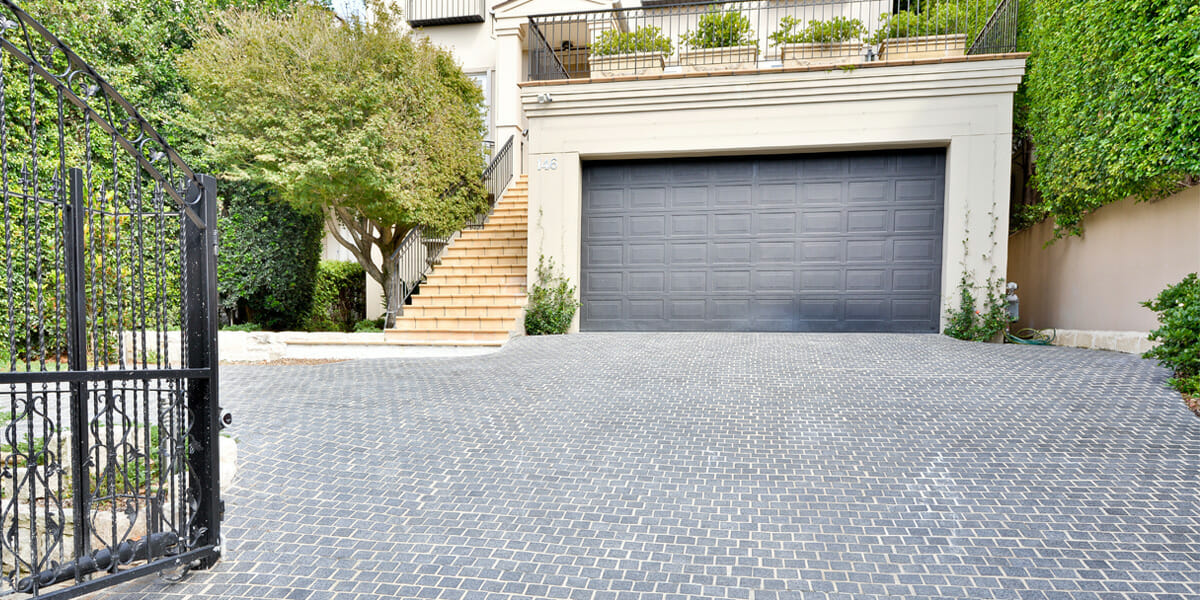
Are you frustrated that your crazy porphyry paver installations are not turning out as expected?
Uneven surfaces, misaligned patterns, and premature wear can ruin the aesthetics and integrity of your project, leading to wasted time and resources.
Discover tips and techniques to sidestep these pitfalls and achieve flawless results in laying crazy porphyry pavers.
Preparing the Base
A solid foundation is crucial for the longevity and stability of crazy porphyry paver installations. You risk uneven surfaces, shifting pavers, and premature wear without it.
Common Mistakes
- Inadequate Excavation: Not digging deep enough can lead to a weak base. The excavation depth should account for the base material and the paver thickness.
- Improper Base Material: Using incorrect materials, like loose soil or inadequate gravel, can result in poor drainage and instability.
Best Practices for Base Preparation
- Excavate Properly: Dig to a depth that accommodates the base material and pavers, typically 6-8 inches for pedestrian areas and 10-12 inches for driveways.
- Compact the Soil: After excavation, compact the soil to create a stable sub-base. This step is crucial for preventing settling and movement.
- Add a Gravel Layer: Spread a layer of gravel or crushed stone (typically 4-6 inches deep). Compact this layer thoroughly to ensure stability and proper drainage.
- Top with Sand: Add a 1-2 inch layer of coarse sand on the gravel. Level and compact the sand to create a smooth, even surface for laying the pavers.
Planning the Layout
A well-thought-out design is essential for laying crazy porphyry pavers successfully.
Without proper planning, you may encounter common issues such as a lack of coherence in the design and uneven spacing between the pavers, which can compromise the installation’s aesthetic and structural integrity.
Common Mistakes
- Lack of Planning: Rushing into the project without a clear design can lead to a disorganised appearance and increased material waste.
- Uneven Spacing: Inconsistent gaps between pavers look unprofessional and affect the installation’s stability and durability.
Tips for Effective Layout Planning
- Sketch Your Design: Begin with a detailed sketch of your desired layout. Consider the shape and size of the area, and decide on any specific patterns or motifs.
- Measure Accurately: Measure the area precisely to ensure the pavers fit perfectly. Use tools like string lines or chalk to mark the layout on the ground.
- Mock Layout: Before setting the pavers permanently, lay them out in the desired pattern to visualise the final look and make any necessary adjustments.
- Consider Functionality: Plan for proper drainage and accessibility. Ensure that the layout accommodates the natural flow of water and foot traffic.
Choosing the Right Materials
The success of your crazy porphyry paver project hinges on selecting high-quality materials. Using the right pavers and adhesives ensures durability, aesthetic appeal, and longevity.
Common Mistakes
- Using Substandard Pavers: Low-quality pavers can crack, chip, or discolour quickly, leading to frequent repairs and replacements.
- Inappropriate Adhesives: Choosing the wrong type of adhesive can result in poor bonding, causing pavers to shift or come loose.
Guidelines for Selecting Suitable Materials
- Choose High-Grade Pavers: Opt for premium-grade porphyry pavers known for their strength, durability, and resistance to environmental factors. Inspect the pavers for uniformity in colour and texture.
- Select the Right Adhesive: Use adhesives specifically designed for natural stone. These adhesives should offer strong bonding properties and resist moisture and temperature fluctuations.
- Check Compatibility: Ensure that the chosen pavers and adhesives are compatible with the base materials and the overall environmental conditions of your project site.
- Source from Reputable Suppliers: Purchase materials from trusted suppliers to guarantee quality. Reputable suppliers often provide detailed product specifications and support.
Proper Installation Techniques
Proper installation techniques are essential for a durable and visually appealing crazy porphyry paver project.
Following the correct steps helps prevent common issues such as incorrect paver placement and insufficient joint spacing.
Common Mistakes
- Incorrect Paver Placement: Placing pavers unevenly or without proper alignment can lead to an unsightly and unstable surface.
- Insufficient Joint Spacing: Failing to leave adequate space between pavers can cause them to shift or crack over time.
Best Practices for Installation
- Plan the Layout: Before laying the pavers, plan the layout carefully to ensure a coherent design and avoid making major adjustments later.
- Use Spacers: To maintain consistent spacing between pavers, use spacers. This helps achieve a uniform look and allows for joint filling.
- Fill Joints Properly: After laying the pavers, fill the joints with suitable material, such as polymeric sand. This helps lock the pavers in place and prevents weed growth.
- Compact the Surface: Once all pavers are laid and joints filled, use a plate compactor to compact the entire surface. This ensures that the pavers are firmly set and stable.
Key Steps in Laying Crazy Porphyry Pavers
- Prepare the Base: Ensure the base is well-excavated, compacted, and layered with gravel and sand.
- Lay the Pavers: Start placing the pavers from one corner, working your way across the area. Use a rubber mallet to gently tap each paver into place, ensuring they are level.
- Check for Alignment: Continuously check that the pavers are aligned properly, and make any necessary adjustments as you go along.
- Maintain Joint Spacing: Ensure consistent spacing between the pavers for expansion and contraction.
Ensuring Proper Drainage
Adequate drainage is critical for maintaining the longevity and functionality of your crazy porphyry paver installation.
Without proper drainage, water can pool and cause damage to the pavers and underlying foundation.
Common Mistakes
Poor Slope: Failing to grade the installation site correctly can result in water pooling instead of draining away. A slope of about 2% away from buildings is generally recommended.
Blocked Drainage Paths: Neglecting to keep drainage paths clear can cause water to back up and create pressure on the paver surface.
Tips for Achieving Proper Drainage
- Plan the Slope: Before installation, plan for a gentle slope to direct water away from the paved area. A slope of 1/4 inch per foot is typically sufficient.
- Use Permeable Base Materials: Incorporate a permeable base layer like gravel to facilitate water movement through the base and away from the pavers.
- Install Drainage Systems: Consider installing drainage systems like French or channel drains in areas where water accumulation is likely.
- Regular Maintenance: Keep drainage paths clear of debris and inspect them to ensure they function correctly.
Joint Filling and Sealing
Proper joint filling and sealing are crucial steps in laying crazy porphyry pavers.
They ensure your paver installation’s stability, durability, and appearance, protecting it from environmental factors and wear.
Common Mistakes
- Using Incorrect Materials: Choosing the wrong type of sand or filler can result in weak joints that deteriorate quickly. Polymeric sand is recommended for its binding properties and durability.
- Insufficient Sealing: Failing to apply an adequate sealant can leave the joints vulnerable to water infiltration, leading to erosion and instability.
Best Practices for Joint Filling and Sealing
- Select the Right Filler: Use polymeric sand or a similar high-quality joint filler specifically designed for pavers. This material hardens when wet, creating a robust and stable joint.
- Proper Application: After placing the pavers, sweep the filler material into the joints, ensuring they are filled. Use a broom to distribute the sand evenly and a plate compactor to settle it into the joints.
- Clean the Surface: Before sealing, ensure the paver surface is clean and free of residual filler material. This ensures that the sealant adheres properly.
- Apply the Sealant: Choose a sealant suitable for natural stone pavers. Follow the manufacturer’s instructions to apply it evenly over the surface and joints. This step should be done in dry conditions to ensure effective curing.
- Regular Maintenance: To maintain protection and appearance, reapply sealant as the manufacturer recommends, typically every 2-3 years.
Compaction and Finishing
Proper compaction and finishing are essential in laying crazy porphyry pavers, ensuring a stable, durable, and visually appealing surface.
Common Mistakes
- Inadequate Compaction: Failing to compact the base material and pavers sufficiently can lead to an unstable surface, causing pavers to shift, settle, or become uneven.
- Uneven Surface: Skipping the finishing touches can result in an irregular surface, which looks unappealing and can pose tripping hazards.
Tips for Effective Compaction and Finishing Touches
- Compact the Base Material: Before laying the pavers, thoroughly compact the base material (gravel or sand) using a plate compactor. This creates a stable foundation.
- Compact the Pavers: After placing the pavers, use a plate compactor to compact the surface again. To prevent damage, place a protective layer, such as plywood or a compactor pad, over the pavers.
- Check for Level: Continuously check the level of the pavers during compaction to ensure an even surface. Adjust any pavers that are too high or too low.
- Fill Joints Properly: Refill the joints with polymeric sand or another suitable filler material after compaction, then compact again to settle the filler.
- Final Sweep and Clean: Sweep off any excess filler material from the surface and rinse the area lightly with water to help the filler settle and bond. Ensure the surface is clean and free of debris.
Post-Installation Care
Proper post-installation care is crucial to maintaining the beauty and durability of your crazy porphyry paver installation.
Regular maintenance helps prevent damage and prolongs the lifespan of the pavers.
Common Mistakes
- Neglecting Regular Cleaning: Failing to clean the pavers regularly can lead to the accumulation of dirt, debris, and stains, making the surface look unattractive and potentially causing damage.
- Ignoring Sealing Needs: Not reapplying sealant as needed can leave the pavers unprotected from water infiltration, stains, and wear.
Guidelines for Ongoing Care and Maintenance
- Regular Cleaning: Sweep the pavers regularly to remove debris and dirt. To scrub the surface for a deeper clean, use a mild detergent mixed with water and a stiff brush. Rinse thoroughly with water.
- Weed Control: Watch for weeds that may sprout between the pavers. Remove them promptly, and consider using a weed-preventive solution in the joints to minimise growth.
- Reapply Sealant: Depending on the type of sealant used, reapply it every 2-3 years to protect the pavers from stains and weathering. Make sure the pavers are clean and dry before applying the sealant.
- Inspect for Damage: Regularly inspect the paver surface for any signs of damage, such as cracks or loose pavers. Address these issues promptly to prevent further deterioration.
- Avoid Harsh Chemicals: Use gentle cleaning products and avoid harsh chemicals that can damage the pavers or the joint filler.
Conclusion
Preparing a solid base, planning the layout, choosing quality materials, and ensuring proper installation and maintenance can help avoid common mistakes when laying crazy porphyry pavers.
Follow these best practices for a successful, durable, beautiful paver installation.
For expert advice and top-quality materials, consult Splendour In Stone and ensure your project’s success.
More To Explore

Grey Granite Cobblestones for Driveways: Strength and Style
Grey granite cobblestones combine strength, safety, and timeless appeal, making them a popular choice for Melbourne driveways and outdoor spaces. Their natural flamed texture offers

Granite Wall Cladding Melbourne: Modern and Classic Appeal
Granite wall cladding brings both modern sophistication and classic charm to Melbourne architecture. Known for its durability and natural beauty, granite transforms façades, feature walls,


